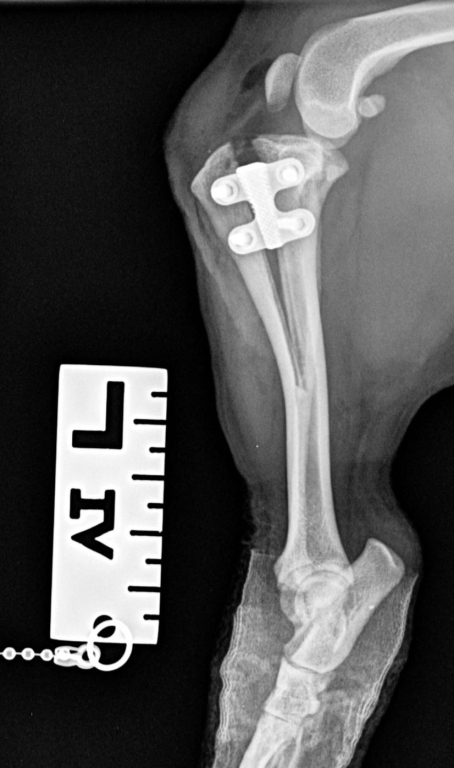
New research has found TTA offers good medium to long-term treatment for cruciate ligament failure
Research Finds TTA Offers Good Medium To Long-term Treatment For Cruciate Ligament Failure
Even in dogs with tibial plateau angles of greater than 30⁰
New research led by Orthopaedic Specialist Steve Butterworth at CVS’ Weighbridge Referral Centre, Swansea has found that tibial tuberosity advancement (TTA)-Rapid, a popular technique to treat cruciate ligament rupture in dogs, offers a good medium to long-term treatment outcome for canine cranial cruciate ligament failure - even in patients with tibial plateau angles of greater than 30⁰.
Cranial cruciate ligament insufficiency (CCLI) is one of the most prevalent orthopaedic problems in canines, affecting 3% to 5% of dogs[i]. It is a degenerative condition that is a common cause of pelvic limb lameness, resulting in stifle instability, mobility dysfunction and pain.
TTA is a popular surgical procedure to treat dogs showing lameness associated with CCLI. Though past research has highlighted satisfactory short (6-12 weeks)[ii] and medium (mean 16 months)[iii] term outcomes, there is limited research on a longer (>16 months) follow-up periods. It has also been speculated that dogs with tibial plateau angles (TPA) of greater than 30⁰ are not well suited for a TTA[iv].
The researchers reviewed patient records for a total of 149 TTA-Rapid procedures carried out in 120 dogs over an 80 month period. They also reviewed owner questionnaires that evaluated the outcome of at least six months after surgery, using a validated clinical metrology instrument, Liverpool Osteoarthritis in Dogs (LOAD). Follow-up questionnaires were received from owners of 64 of the 120 dogs (53.3%), with a median follow-up time of 37.5 months. This cohort included a wide range of breeds, aged between 2&12 years and with bodyweights ranging from 6.3 to 41.8kg. The dogs included 37 females and 27 males, and of the 79 limbs treated in these dogs, 41 were left and 38 were right. The researchers found 26 of the dogs (40.6%) had a TTA performed with a TPA less than 30◦ and 38 (59.4%) with a TPA of 30◦ or more. Of the 79 procedures, meniscal injury was noted in 27 (34.2%), surgery to stabilise the patella was required in 11 (13.9%), there was one surgical site infection (treated successfully with a short course of antibiotics), one dog sustained a fracture of the tibial seven days after surgery, and one sustained a late meniscal tear 12 months after initial surgery (treated successfully by partial meniscectomy).
The outcome was judged to be satisfactory, based on frequency of lameness, in 63 (98.4%), while satisfactory outcomes were achieved in 61 (95.3%) based on severity of lameness and in 50 (78.1%) based on mobility score. Statistical analysis showed that age, bodyweight, tibial plateau angle (TPA), meniscal injury, and concurrent patellar surgery did not influence the outcome, but time to follow-up positively correlated with mobility score (suggesting mobility declined with time from surgery).
The researchers concluded that the long-term (median of 37.5 months) outcome for dogs undergoing TTA-Rapid for cranial cruciate ligament disease is satisfactory, with no risk factors associated with poorer outcomes identified. Their study also revealed no evidence to support the suggestion that dogs with TPAs of greater than 30◦ may be inappropriate candidates for TTA - after testing several parameters to judge outcome including frequency of lameness, severity of lameness, distance walked daily and mobility score.
Steve Butterworth, Orthopaedic Specialist at CVS’ Weighbridge Referral Centre, said: “This research is important in trying to ensure that decisions on whether to use this treatment modality, are based on sound clinical evidence. The only factor identified that influenced the outcome measure was that of time since surgery. All other factors, including TPA, had no effect on the outcome.”
The TTA-Rapid for treating the canine cruciate deficient stifle: Medium to long-term outcome and analysis of risk factors paper has been now published in Vet Record TTA‐Rapid for treating the canine cruciate deficient stifle: Medium to long‐term outcome and analysis of risk factors - Butterworth - Veterinary Record - Wiley Online Library .
CVS Group operates across small animal, farm animal, equine, laboratories and crematoria, with over 500 veterinary practices and referral centres in the UK, the Republic of Ireland and the Netherlands. In the last five years the company has invested nearly £80 million in its sites, facilities and equipment, in addition to industry leading training and support, to give the best possible care to animals. For more information about CVS Group visit www.cvsukltd.co.uk.
[i] Hynes J, Manfredi JM, Shull SA. Cranial cruciate ligament disease is perceived to be prevalent and is misunderstood in field trial sport. J Am Vet Med Assoc. 2023 Jul 14:1-6. doi: 10.2460/javma.23.01.0004. Epub ahead of print. PMID: 37451677.
[ii] 1. Samoy Y, Verhoeven G, Bosmans T, Van der Vekens E, de Bakker E, Verleyen P, et al. TTA Rapid: description of the technique and short term clinical trial results of the first 50 cases. Vet Surg. 2015;44:474–84.
Butterworth SJ, Kydd DM. TTA-Rapid in the treatment of the canine cruciate deficient stifle: short- and medium-term outcome. J Small Anim Pract. 2017;58:35–41.
Dyall B, Schmökel H. Tibial tuberosity advancement in smallbreed dogs using TTA-Rapid implants: complications and outcome. J Small Anim Pract. 2017;58:314–22.
[iii] Boudrieau RJ. Tibial plateau leveling osteotomy or tibial tuberosity advancement? Vet Surg. 2009;38:1–22.
[iv] Boudrieau RJ. 2007 ACVS Veterinary Symposium - the surgical summit: pre-symposium laboratories: TTA Lab. October 18–21 Chicago, Ilinois. Published ACVS Germantown, MD, 2007.
Williams N. Cranial cruciate ligament rupture and tibial tuberosity advancement. Veterinary Times. September 14, 2009. https://www.vettimes.co.uk/app/uploads/wp-post-topdf-enhanced-cache/1/cranial-cruciate-ligament-ruptureand-tibial-tuberosity-advancement.pdf.
More from CVS UK Ltd
- New study reveals key prognostic indicators in canine mast cell tumours
- Ernie’s ball trouble: Managing a challenging oesophageal foreign body
- New study reveals need for cultural change and increased safety focus in companion animal veterinary practices
- CVS Group halves the amount of waste going to landfill
- CVS supports innovative PhD to promote responsible prescribing habits in veterinary practice

 2 years ago
2 years ago  1252 views
1252 views
